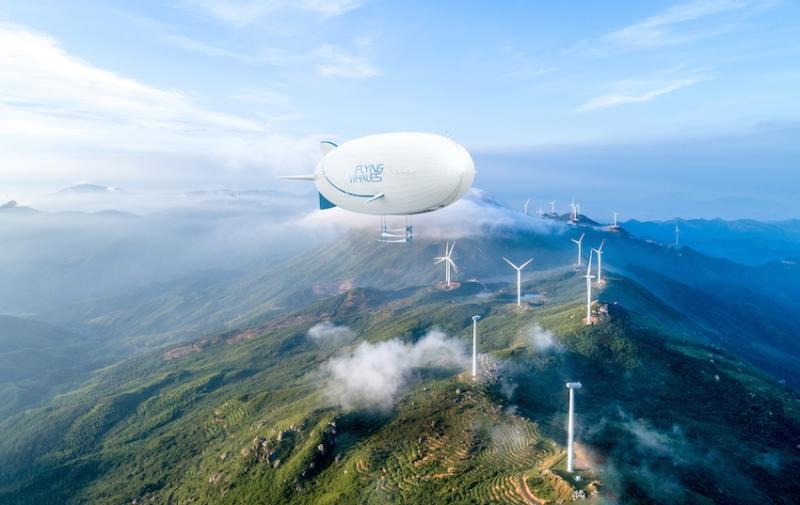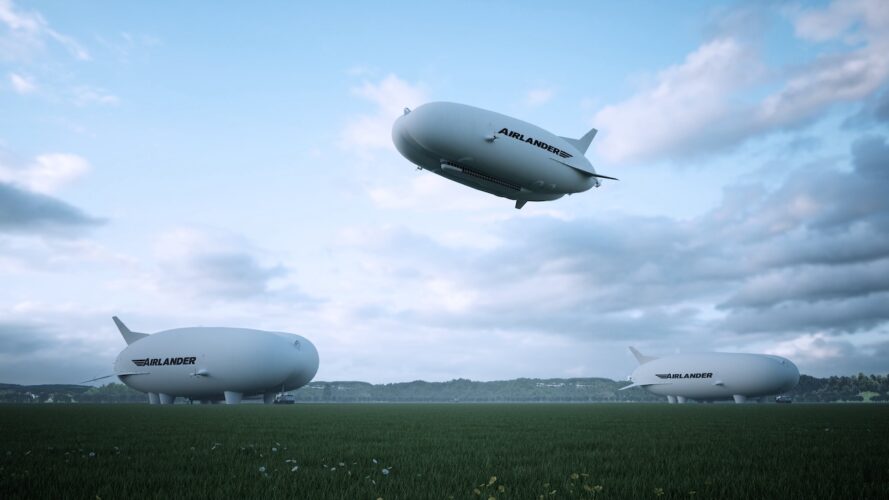"Wild idea:" Could zeppelins really be used to air-ship huge wind turbine parts?
By: Rachel Williamson (RenewEconomy)


Gotta love enviro-geeks. When it's pointed out that wind farms tend to be windy, the problem is simply dismissed with future tech miracles. Notice the deflection about aerodynamics of wind turbine blades? Apparently the developers haven't heard of packaging. You know, just wrapping a tarp around the load overcomes the problem of the blades trying to fly.
And, of course, the problem of a giant gas bag acting as a sail in a windy environment shouldn't impede the flow of money to develop the aircraft. Just spend more money and a miracle will occur.

It's an intriguing vision for the future of renewable energy. Giant white blimps slipping silently through the air carrying containers of solar panels, or, more likely, wind turbine blades which are expensive and devilishly tricky to move by road.
One of the biggest logistical challenges for renewable energy projects - and wind farms in particular - is the task of transporting heavy towers and turbine planes from ports to the project sites.
And finding a solution to this is the aim of French company Flying Whales, founded by entrepreneur Sebastien Bougon, who has already established bases in France and Canada and is now looking at opportunities in Australia.
"We looked at the market in Australia and there was a fantastic surprise, how much you are revamping your energy generation and energy network," Bougon told Renew Economy.
"What we do today is work with all players to look at their business cases. For instance, wind farms in Tasmania, New South Wales, Queensland or in Western Australia, and work with those companies to check out the technical feasibility, to check out the financial feasibility, and to confirm that when we [start operations in] 2028, everything is OK."
Bougon is focused on metrics like the huge numbers of turbine blades needing to be installed in Queensland alone - as many as 40,000 in the coming year. Mt Isa in Queensland's north-west has already been announced as one of the company's six operations sites, with a second site imminent.
Bougon also sees opportunity in new and replacement transmission infrastructure along Australia's strung out grid. A helicopter can carry 5 tonnes of weight, or a fifth of a transmission tower.
Bougon says one of his airships could carry the whole thing - in a cargo hold inside the "belly of the whale" or attached to the bottom if it's more than 100m long - to a remote site fully assembled, and do it more cheaply.
Flying Whales is yet to take ownership of a completed model; engineering is complete, testing is underway, assembly is next and the first airship - a 200m long behemoth called LCA60T - will be ready in 2026 for certification.
Cutting out road transportation could improve project economics, says aviation researcher Craig Neal, who wrote a paper on the feasibility of heavy airship transport in 2016.
"Using airships to move renewable energy equipment is definitely feasible," he told Renew Economy.
"What's attractive with airships is they can make the actual transportation much simpler. It's extremely complicated, takes a lot of planning, there is a lot of cost involved, and it's very slow."
But there are also some big question marks over critical details.
A wind industry source from a large global company suggested that airships would require their own set of infrastructure, such as a suitable lay-down 'airport' area with a tethering tower and a similar set-up at port, and all would need to be approved by aviation regulator CASA.
And as another pointed out, wind sites tend to be windy.
Figuring out how to deal with an aircraft that is lighter than air to deliver equipment to those areas could be the sticking point in any future featuring blimps.
Wind farms are windy
"Wow, incredible. It's a pretty wild idea," were the first comments out of the mouth of Stromlo Energy cofounder Garth Heron when asked about the prospect of airship deliveries.
Airships wouldn't be suitable for moving a giant 477 tonne grid transformer, like the one needed for the Waratah Super Battery in New South Wales (NSW), although the third iteration of a model proposed by US company AT2 Aero could carry up to 450 tonnes.
But Heron points out that shipping wind turbine blades by air could be more dangerous than other methods.
"The component that they will be thinking of moving that are the most difficult to move are things like turbine blades," he told Renew Economy .
'What wind turbines are very good at is catching wind. [So] on the safety aspects they would have some incredible challenges."
Heron says the amount of movement that can happen even when lifting a blade from the ground with a crane is "quite scary", so safety while loading and unloading is the biggest problem an airlifted blade would pose for airship transportation.
Another wind industry source says deliveries would be reliant on wind speeds on the day, potentially making airship deliveries less reliable than the more laborious road method.
While some companies are proposing models that are loaded while on the ground, Flying Whales' method is to use a "sling" to lift and lower cargo into an airship's hold while in the air.
Bougon acknowledges the concerns around wind and reliability, but says they have built in safeguards against this as part of the original design brief.
"Our airship is actually a flying crane and when a crane installs blades on masts there can't be a lot of wind, so it's exactly the same for us," he says.
The wind speed limitation while loading is the same as for a helicopter, of 40km/hour, if a helicopter was doing the same job. The wind speed limit a Flying Whales airship could take during flight is 100km/hour, he says.
The whole thing is stabilised with 4 megawatts (MW) of engines placed around the airship.
"We have 4 MW of embedded power around the airship [in] 32 electrical engines [powering] 32 propellers in order to stabilise it and ensure perfect behaviour," Bougon says.
"Electric engines can distribute the forces all around and you can stablise the drone much easier than it's exactaly the same as the aisrship, as soon as we could have electrical engines,… we could have complete stabilisation.
"It's the evolution of the electric propellers and engines that could make drones happen, that could make this large airship feasible in terms of stabilisation when you load and unload."
Other challenges also abound, such as the issue of variable buoyancy.
This is where an airship needs to account for the change in weight during drop off and pick up of loads. Releasing helium - priced at $35/cubic metre - isn't feasible.
Flying Whales plans to carry up to 60T of water as ballast, while LA-based Aeros has developed a compression system, where helium is compressed and released inside the airship depending on the need.
Get rid of roads
If airshippers can convince renewables developers of their safety, they will then be able to appeal to their wallets: cutting out some tens to hundreds of millions of dollars in road upgrades between ports and sites.
"The issue is really about the cost of the road upgrade. That's the problem this could potentially solve," Heron says.
Logjams on roads is an issue that wind developers in Queensland are already worried about.
A report last year into wind equipment transportation by the Queensland Transport and Logistics Council outlined just how complicated the process is to move very heavy items from port, through towns and into regional areas.
"QTLC members have raised concerns regarding inefficiencies and constraints in current wind farm development processes, from the initial development application process through to the transportation of componentry and materials,' the report said.
"If nothing is done, with the increase in wind farm projects coming online, these inefficiencies and constraints have the potential to significantly impact wind farm project delivery and increase costs."
| Model | Payload | Cargo dimensions |
| Flying Whales LCA60T | 60T | 96m long x 8m high x 7m wide |
| Hybrid Air Vehicles Airlander 10 | 10T | N/A |
| AT2 Aerospace Z3 | 453T | N/A |
| Atlas LTA Advanced Technology ALANT 300 | 165T | 51.5m long x 8.7 high x 14 wide |
| Euro Airship | 10T - 400T | N/A |
Examples of the size of airships being proposed today.
Heavy lifters
Flying Whales is the only airship proponent seriously targeting Australia as yet, but it's not the only company out there.
Hybrid Air Vehicles in the UK has already built and tested its pilot "flying bum" airship.
Also in the UK are SkyLifter, Varialift Airships and Aeromechanics.
Lockheed Martin spun its airship division out into AT2 Aerospace in the US, while Aeros, Blimp Works and Solar Ship are also based in North America. Israel has Atlas LTA Advanced Technology, Argentina has Aero Vehicles and France also has Euro Airship.
 Image: Hybrid Air Vehicles. The so-called “flying bum” Airlander 10.
Image: Hybrid Air Vehicles. The so-called “flying bum” Airlander 10.
Economics might stack up
Aviation researcher Neal speculated in his 2016 paper that airships would be doing the heavy lifting in Australia by 2020.
He says today the reason why that forecast didn't happen is money.
"I think it's been the age old story of investment. The funding has always been the issue," he says.
"When Boeing developed the Boeing 787 [Dreamliner] it was some phenomenal amount of money they spent, something like $35 billion or something. If you had a fraction of that money going into airships we'd have different models running."
Neal's 2016 research focused purely on the economics of what airships might be useful for, and said the oversize overmass (OSOM) market was where gains could be made.
"They have the ability to vertically takeoff and land like a helicopter; to operate over long distances; and to carry vast cargo loads in terms of weight, volume and dimensions. Yet, depending upon the size and model of cargo airship, their cost per freight tonne kilometer (FTK) may be at a comparable cost to general road freight and significantly cheaper than current air freight," he wrote at the time.
"The nature of the item being transported, the level of difficulty in the route taken, time of year, weather conditions and many other variables can make the level of planning and coordination required for these movements highly resource intensive.
"To date there hasn't been a practical alternative to get an OSOM item to site, as rail and traditional air (both fixed wing aircraft and rotary wing) have limitations which make their employment unfeasible."

Tags
Who is online
40 visitors


A case can be made, on paper, to deliver the turbine blades by parachute drop from fixed wing aircraft. But no amount of money will overcome the rather obvious challenges posed by the real world.